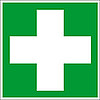University members are insured against the consequences of an accident while studying or working at the University.
More information on accident insurance and accident report for
| Contact details: Dr. Ursula Häuser +49 711 459 22976 | Visitors’ address: | Office hours: Mondays and Wednesdays between 8 a.m. and 4:30 p.m. |
Occupational Health Physician’s tasks:
- Advising the employer and the persons otherwise responsible for occupational safety and accident prevention, in particular on:
- the planning, execution, and maintenance of operating facilities and of social and sanitary facilities;
- the procurement of technical work equipment and the introduction of work procedures and working materials or the selection and testing of personal protection equipment, occupational physiology, occupational psychology and other ergonomic and occupational hygiene issues, in particular work rhythm, working time, and break regulations, the design of workplaces, work processes, and the working environment;
- the organization of first aid at the University.
- Issues relating to job changes and the integration or reintegration of disabled people into the work process and the assessment of working conditions.
- To examine employees, assess them, and advise them on occupational health and safety and to record and evaluate the results of the examinations.
- To inspect the workplaces at regular intervals together with the safety officer and the Staff Council.
- Investigate the causes of work-related illnesses, record and evaluate the results of the examination, and propose measures to the employer to prevent these illnesses.
- If the employee so requests, the campus physician must inform the employee of the results of occupational medical examinations.
- Advice for pregnant women (especially when working with substances that are harmful to health)
- Travel medical advice for business trips abroad and required vaccinations
|
|
Please also observe the accident prevention regulations.
There was an accident at work and the person needs to be taken to the doctor?
Info sheet: The correct transport after an accident at work
Form for covering the costs of a taxi
What to do in an emergency
Get an overview of the situation
Keep calm - it's easier said than done when there is an emergency. However, nervousness, insecurity, or fear should not be shown to the people affected. That's why it helps to get a quick overview:
- Cause of accident?
- How many people are involved?
- How are the people acting?
- Hazards? (spilled gasoline, moving traffic, fire or smoke, hazardous materials truck, etc.)
- Are other people already helping?
Call emergency services with 0-112
 | In order to be able to guarantee effective first aid, defibrillators have been installed at 12 locations at the University of Hohenheim. The defibrillators can save lives in the event of ventricular fibrillation. |
Here is where you can find defibrillators:
- Hohenheim Palace, west wing, 1st upper level in the hallway of the Human Resources Department (04.12)
- in the Departmental Library next to the entrance (04.13)
- Hohenheim Palace, museum wing, ground floor, opposite the Mailroom (04.15)
- in the Biology Building II, ground floor, opposite the facility manager's office (02.31)
- in the Euroforum, ground floor, on the right-hand side next to the entrance (02.65)
- in the Central Library, foyer (03.31)
- in the sports hall, 2nd equipment room (01.51)
- German Agricultural Museum, Garbenstr. 9a, entrance area, opposite the reception desk (03.12)
- German Agricultural Museum, Filderhauptstr. 179, entrance area, opposite the cashier’s desk (08.51)
- Wollgrasweg 23, 2nd floor, copy room, room 241 (80.14)
- Wollgrasweg 43, entrance area, after post office on the left, room 0.21 (80.15)
- Wollgrasweg 49, entrance area, to the left of the stairs, room 34 (80.16)
- Emil-Wolff-Str. 12, entrance area, left (01.12)
- Garbenstr. 25, entrance area, right (03.41)
- in the Apicultural Institute, in the staircase to the right of the main entrance (02.55)
- in the Ecology Center, lecture hall building, at the lecture halls Ö1 and Ö2 (02.23)
- in the Collection Greenhouse, next to the first aid room (02.53)
- in the Meiereihof, in the administration building, stairwell on the ground floor (05.21)
Please contact the Occupational Health and Safety Department if you
- are interested in training sessions and instructions
- need to report irregularities such as theft or vandalism

